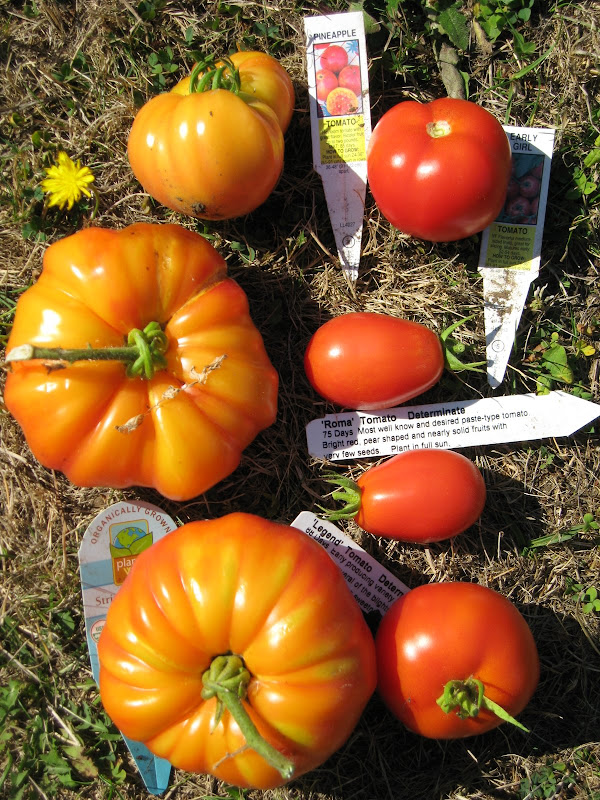I have my own personal answer to the question: the tomato. I want to be able to eat a tomato that's as fresh as possible. One that's never been refrigerated, chilled only by the Portland's cool summer nights. I remember years ago buying a tomato from the local grocery store and cutting it open. It was red, but where was the taste? I almost cried while I ate the stiff tasteless fruit, longing for the fleshy, winey, red specimens I could pick up at almost any market in France. Why do Americans put up with such bland produce (and bread, but that's another story)? The only reason we have these tomatoes is because they're easy to ship across the country and let ripen in the truck or in the back room of the supermarket. I wanted something that was delicate and tasty, warmed by the sun, from the vine to my kitchen.
So, I started a garden. That was 17 years ago. The first year I started all my plants from seed, but a 4'x8' plot won't hold twenty tomato plants, let alone bush beans, lettuce, spinach and hot peppers. Since then I've bought starts in 4" pots from Portland Nursery, tilled some compost, and let them grow in well-turned soil.
Last year I took photos and made notes of which tomatoes were successful, and which were... eh, not so much. My perfect plan was to take this list to Portland Nursery and get exactly the tomatoes I wanted, and then I could shoot in the dark for fillers to replace the less successful plants.
I immediately ran into problems: Portland Nursery changed the layout of their tomatoes, and they were promoting more organic plants. I needed help finding the heirloom tomatoes, and then they had at least three different "German" varieties. I had less trouble locating the Legend tomatoes, but couldn't find the other tomatoes I wanted. I ended up choosing a random Roma, and some other varieties.
In total I bought 8 tomato plants, a cucumber, three hot peppers, three basil plants, and a summer squash. One of the tomatoes (the German Striped) was 100% organic in a compostable pot and bag for $9. The rest were between $1 and $3 a pot. Add to that two cubic feet of Bumper Crop compost and the total outlay for my garden this year was $41.
The results? Mixed.
Early girl didn't live up to its name, ripening a week or so after the first Legends. Also it didn't have nearly as much fruit this year.
In fact, except for the Romas I got almost half as much fruit this year as last. I don't know whether to chalk that up to the heat wave in late July, my change to the watering system (from sprinkler hose to drip hose) or to my compost. Usually I buy chicken manure, but this year opted for the Bumper Crop. Bumper Crop seemed great for the leafy green stuff, but I think I'll stick w/manure for tomatoes and peppers.
Of all the plants the Romas were the best producers. Starting in early August and still going in late September I got enough for several batches of spaghetti sauce (they also mix with other tomatoes to make a good salsa).
But, for taste, the heirlooms were the clear prize winners. You'll never find either Pineapple or German Striped tomatoes at any grocery store. Both had thin skins, lopsided shapes and ripened into something between yellow and red. The Pineapple tomatoes grew so large my son thought they might be small pumpkins. Unfortunately the thin skins made them attractive to the slugs (who hardly touched any of the other tomatoes), but I had enough to share. A single Pineapple, a half an onion, and some cilantro was enough to make a healthy bowl of fresh salsa. The German Striped tomatoes were almost sweet, and I blended up one to make a sauce for a pizza that the family said was "the best ever."
Thus endeth my gardening log for this year. Next year we'll see if I can find any of the same tomatoes. In the meantime, my final answer to "Why Garden?" is "the secret is in the sauce."
Download Portland Nursery's Veggie Calendar |
A sample of the bounty






![Reblog this post [with Zemanta]](http://img.zemanta.com/reblog_e.png?x-id=d2c0d5df-8c11-418a-bb3d-07ce2a70b91d)
No comments:
Post a Comment